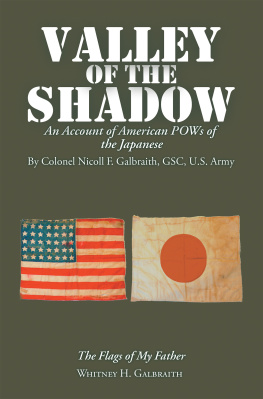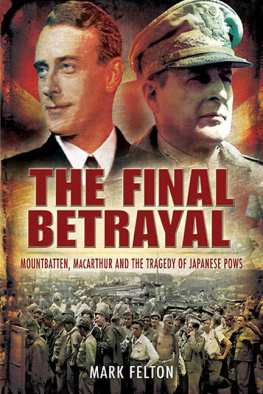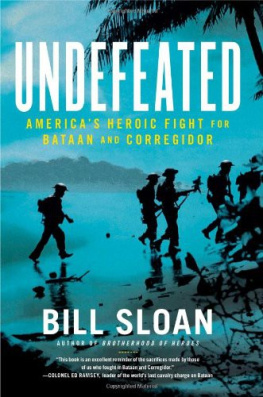Valley of the
Shadow
An Account of American POWs of
the Japanese
B y Colonel Nicoll F. Galbraith,
GSC, U.S. Army
Copyright 2018 By Colonel Nicoll F. Galbraith, GSC, U.S. Army.
Library of Congress Control Number: | 2018907236 |
ISBN: | Hardcover | 978-1-9845-3591-7 |
Softcover | 978-1-9845-3592-4 |
eBook | 978-1-9845-3593-1 |
All rights reserved. No part of this book may be reproduced or transmitted in any form or by any means, electronic or mechanical, including photocopying, recording, or by any information storage and retrieval system, without permission in writing from the copyright owner.
The views expressed in this work are solely those of the author and do not necessarily reflect the views of the publisher, and the publisher hereby disclaims any responsibility for them.
Any people depicted in stock imagery provided by Getty Images are models, and such images are being used for illustrative purposes only.
Certain stock imagery Getty Images.
Rev. date: 11/23/2020
Xlibris
844-714-8691
www.Xlibris.com
773617
Contents
Psalm 23 King James Version
The Lord is my shepherd; I shall not want.
He maketh me to lie down in green pastures: he leadeth me beside the still waters.
He restoreth my soul: he leadeth me in the paths of righteousness for his names sake.
Yea, though I walk through the valley of the shadow of death,
I will fear no evil: for thou art with me; thy rod and thy staff they comfort me.
Thou preparest a table before me in the presence of mine enemies: thou anointest my head with oil; my cup runneth over.
Surely goodness and mercy shall follow me all the days of my life: and I will dwell in the house of the Lord forever.
King James Version (KJV)
Dedicated to Col. Nicoll F. Galbraith, Jr.,
Medical Corps, U.S. Army Reserve.
Elder son of Nick Galbraith and family
champion of our fathers experience.
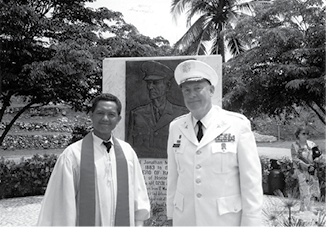
(NFG, Jr. with pastor)
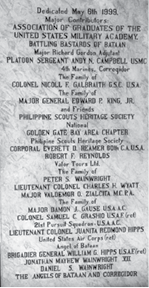
| 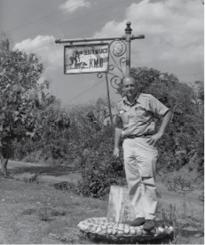
|
(Corregidor Memorial) | (NFG, Jr., at Death
March marker) |
This volume is the true rendition of the never before published Valley of the Shadow . The manuscript was written by my father, Colonel Nicoll F. Nick Galbraith, GSC, United States Army, in the 1950s in Colorado Springs following his retirement. Written in longhand on 1,100 flimsies, it is Nick Galbraiths historical narrative describing his three and a half years as a prisoner of the Japanese, from the surrender of Corregidor in May 1942 until August 1945. At that time, he was rescued/released from Camp Hoten, in Mukden, Manchukuo/Manchuria, at the hands of a six-man OSS team and Russias Red Army, which had just entered the Asian war. My fathers account is written in the third person, using pseudonyms for the characters. The principle five men he personifies represent a composite of his associates while on the staff (G-4, Logistics) of General Jonathan M. Wainwright, commander of United States Forces in the Philippines (USFIP) and his various roommates during their years of captivity. There is otherwise very little in this story that is fiction. The narrative reflects in detail his personal memory, reinforced by his extensive diary collection that he was able to maintain during his years of incarceration.
With rare embellishments, every episode, conversation, characterization, and soliloquy reflects a true account of the experiences of Nick and of his fellow POWs and their Japanese captors. Many of the passages are direct quotes from his real-time, first-person diary entries. As such, it is an accurate and intense portrayal of the lives of senior American officers captured during the fall of the Philippines in 1942, following the defensive campaigns on Bataan and Corregidor.
Valley of the Shadow reflects a stream of consciousness, even a catharsis of his soul during and after Nick Galbraiths years of severe degradation of his very existence and that of his prison mates. He believed that a narrative format, rather than a simple chronology, allowed him to impart the often-disturbing emotions that drove POW mentality and behavior. Perhaps a prime audience for Valley of the Shadow would be those in the psychological and sociological professions, as the story delves deeply, and with a good deal of cynicism, into the psychologic and moral responses of senior American officers, generals, and colonels in times of extreme deprivation at various prison camps. The account refers occasionally to Allied officers, British and Dutch, captured elsewhere in Asia.
Nick Galbraith devotes entire sections in his diaries to subjects such as Failures in Personnel, Discipline, and Camp Rosters and offers here a more interpretive account of POW life than the more chronological diary accounts of his fellow POWs listed in the bibliography. These authors, together with Nick Galbraith, cross-reference each other extensively. While often appearing as the camp scold, Nick Galbraiths was a more benign, analytic, and fastidious persona, causing him to usually hold his reflexive fire in front of his associates. To a modern audience, Nick Galbraiths accounts of personal behaviors and attitudes of his fellow officers often reflect the adolescent and ridiculous behavior of televisions MASH characters!
A controlling factor in this psychological morass is the insistence by the Japanese that no ranks or normal military hierarchy among the captive Americans could be acknowledged, thus obviating any coordination, command, or internal organization among the POWs themselves. Each prisoner, thus, survived as best he could as a lone actor, not subject to normal social or professional conventions. The resulting selfishness of the prisoners was a dominant theme of Nick Galbraith and an extremely disappointing one to him, as his attempts and that of other POWs to remain civilized under uncivil circumstances were difficult at best, often not being reciprocated among their fellows.
Of particular interest to me is my welcome association in recent years with Mr. Harold Hal Leith and his wife Helen, who, decades after the war, I found residing in Golden, Colorado, a ninety-minute, highly expectant drive from my home, in Colorado Springs. On August 16, 1945, Sergeant Hal Leith was one of the six parachutists who Galbraith refers to. Hal Leith at the time was a twenty-five-year-old member of the OSS team, ordered into Camp Hoten as part of Cardinal Mission by General Wedemeyer from Chungking, China, to find General Jonathan M. Wainwright and other senior American officers thought to be in that camp. Hals own account, POWs of Japanese Rescued (2003), is an almost synoptic minute-by-minute account of the mission described in his diaries by Nick Galbraith himself. It was Hal Leith who was initially responsible for General Wainwrights ability to join the Japanese surrender on the quarterdeck of the USS Missouri in Tokyo Bay.
This narrative begins arbitrarily with remembrances of combat episodes in early 1942 when American forces were defending the Bataan peninsula and, subsequently, the fortified island of Corregidor. It then jumps ahead to a description of several of the characters while imprisoned at Karenko, Taiwan. It then sequences through other prison camps, including Shirakawa (Taiwan) and Cheng Tia Chung and ultimately makes its way to Mukden, Manchuria. In one telling section, Nick Galbraith describes time spent on the prison ship Oryoku Maru , weeks before that vessel, containing a later batch of American POWs, was sunk by American aircraft.
Next page
